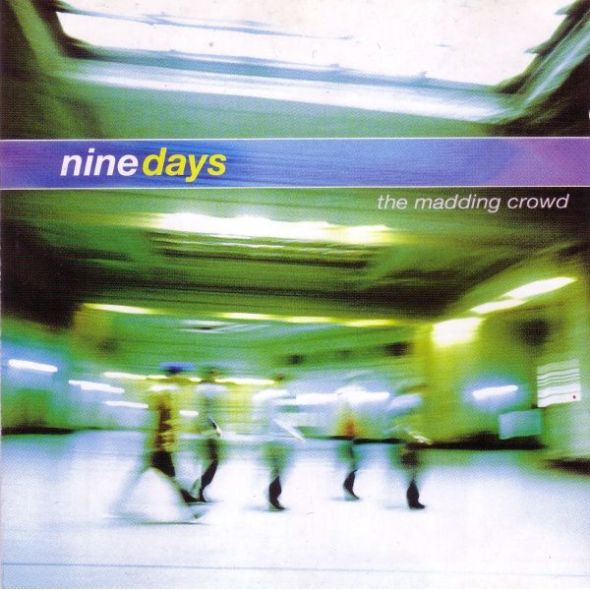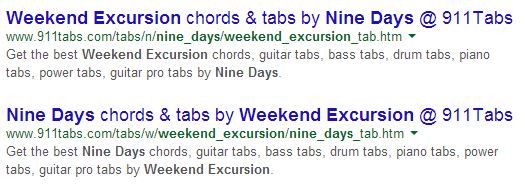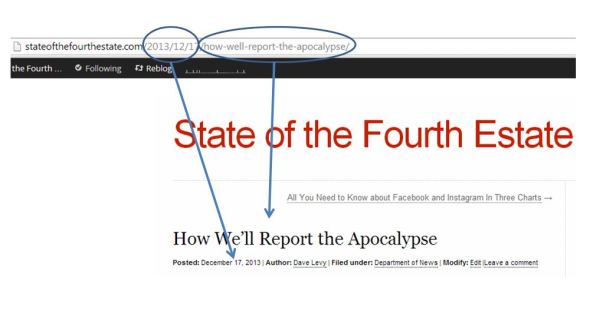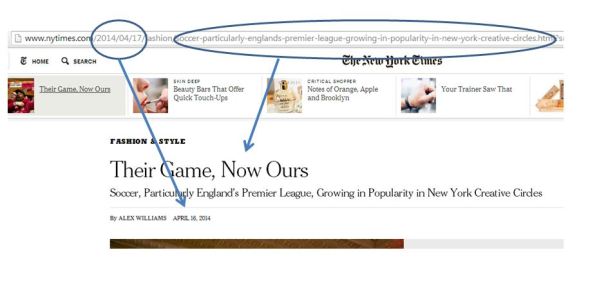Absolutely (Story of a Band) and Discovery in the Post-2.0 Era
Posted: May 22, 2014 | Author: Dave Levy | Filed under: music, social media | Leave a commentAbout 14 years ago this week, a previously underknown Long Island band released a pretty great studio album, one that would eventually cross the platinum threshold. It was driven by a song that was is the most Turn of the Millennium Top 40 track, and the hook is buried in your head forever:
The band, because there is potential you have forgot them, was (is, actually, they’re still out there) Nine Days. I loved that album. Some of those songs were the first I ever learned to play on guitar. So I started to read up on the them, learn their back story. This was an ancient era of the Internet where we didn’t have to Wikipedia depths we do now, but we did have message boards and web rings and community forums.
The great part about these communities and Nine Days in particular: they started to get involved. The band dates to the mid-90s, and these sites actually had the back catalog of self-recorded music with the blessing of the band, because there wasn’t exactly a great place to put 7 years of music back then. I’ll never forget the time I posted to one of the sites about getting too excited because I thought I saw them on a flight from California to Phoenix, and the guitarist posted back to me that it was them and I should have said “Hi”. We all have our different fan-boyings.
The first part of this post is how much that is common place now. I know the band follows me on Twitter (I’m good for one or two bad 90s pop rock comments per week, after all), and more than once, we’ve traded likes and favs and whatnot. It was novel in 2000. Now it’s expected. I mean, hell, you apparently have to use Instagram for Crisis PR these days if you’re in entertainment.
The second part to me is a lot longer trip down a wormhole of peer-to-peer media, and, in all of its glorious serendipity, revolves around a probably well-intentioned ID3 tag on a MP3.
You don’t need to read URLs and guitar tabs to notice something funny here: those two pages are chords for the same piece of music. And it is this song by a Raleigh, NC local band called Weekend Excursion (the song itself is called “Nine Days”):
In 2000, we still had our Napster. If you remember the green, yellow and red lights of your first LAN connection, you may also remember that the ID tags from MP3s played a role in determining how songs ended up listed in the search query. Discovering a band on the radio or MTV in 2000 meant you may just go to your computer and find everything possible by that artist. And if something was mislabeled, they could end up in your download queue. 2 hours later, you may just sit down and listen – not paying attention to the names in WinAmp but thinking, “Wow, his voice sounds really, really different on this one.”
My Googling skills were nowhere near what level they are now, but back then, I could always figure out how to pull together a query to find lyrics and chords. I was getting frustrated when I couldn’t find this song though, until I made the discovery (and I can’t remember how): the tag was wrong. This wasn’t that band from Long Island. Which bore a new quest of discovery: find everything by Weekend Excursion. And, of course, I did the best I could.
We move our 14 years along, and this process has again been radically changed. Peer-to-peer music sharing doesn’t have the same existence, let alone potential error of a mismatched song. Streaming is official, paid, part of us – and the entire Weekend Excursion catalog (and parts of the Nine Days catalog) – and pretty comprehensive.
Which leads to the question: in knowing what we are looking for and the fact that we know we can find it…do we take out the element of surprise? Not just music, but media, too. By becoming over niched and content on perfect knowledge, we can’t let the happy accidents come to be. I wouldn’t have found another band or even kept going down that rabbit hole, because I don’t have a source other than an asterisked-perfectly algorithmed Discover tab or Pandora station. In media, it goes the same: we have the safe reliability in an obscene amount of channels.
Serendipity, I’ll remember the times we had together.
Four Reasons Why PR People Need to Know WordPress
Posted: April 17, 2014 | Author: Dave Levy | Filed under: Department of Digital, social media | 1 CommentMy biggest advice to someone in PR right now is to learn WordPress. Seriously.
— Dave Levy (@levydr) April 17, 2014
I got decent feedback to a tweet this morning on my point that PR people should all know WordPress, and was pushed for a little more background. So, here you go, four reasons why PR People Need to Know WordPress (excuse the list and superlative style headline, if you would).
1. Someone You Need to Convince of Your Value Uses WordPress
WordPress is almost certainly in the bag of tricks of journalists at publications of all types and sizes. Even the traditional mainstays and some broadcast organizations leave the WordPress black bar to indicate that it is the CMS running their world (Time and NESN are just the first two that comes to mind for me). For journalists, especially if they’ve been in J-school recently, self-publishing has long been part of the curriculum – they aren’t afraid of the blinking cursor and the publish button, in fact, they more than likely are uploading their posts into WordPress themselves and not having a webmaster typeset them.
You may never get into a conversation with a journo about how they use WordPress (I vividly only remember one, and that was about whether or not it’s good-practice to draft in WordPress…which I’m totally doing right now), but you should keep in mind that they have a mentality of publishing themselves and working within the limits of the online-editor-space. For example, WordPress doesn’t play nicely with java-based embed codes – so if you are asking for a reporter to include a video, make sure it’s on YouTube where there are multiple ways of embedding. WordPress also is fickle when it comes to images that aren’t hosted on the same website as the CMS, so make sure to provide a file, not a link to where the photo may be elsewhere on the Web so that the reporter can upload it.
It’s not just media websites, though, that implore you to know about WordPress. Far beyond just blogs, WordPress is the tool that manages the entire site for many different types of organizations. If you’re going to be savvy about a client’s website, content on its pages and the underlying analytics that manage them all, understanding that it was built on WordPress could make you an additional asset to the team. More on this later.
2. You Can Use WordPress Like a DuoLingo for the Language of Online Journalism
Like ancient Latin, no one speaks HTML or writes it from hand anymore these days, but its structure and core are essential to everything that is behind the words and numbers you see on the screen. PR people will never need to draft a full page from <head> to </html> or even take their crack at reading source code or a Dreamweaver build, but as it sits at the root of the Internet we play on every day, knowing where those things are and what they mean can be invaluable. The most important that comes to mind is the syntax that WordPress creates, how to read the URL itself as the new headline to gain information about the date and post without even clicking through (aside, I’m sad that it’s been this long since I’ve written here – the example is my last post on this blog):
Using WordPress’s visual editor takes some of the wonder out of writing code, but it is helpful in telling you the key information that you want to consider. One step further, it may help you figure out whether or not you have enough information to make something compelling. Including a link? WordPress compels you to add a title tag when adding it to text or an image – information that not everyone will see, but a perfectly good test for you to say, “Is this valid enough that the information stands on its own or does it need more context to be explainable?” You don’t need to <a href> it yourself, but it’s there to guide you to good practice.
3. Wordpress Teaches Old Dogs New Tricks
Understanding the system means also knowing how it can be manipulated and what you can learn without ever having to write code, as well. The fast list of what you can learn simply by logging into a site’s /wp-admin:
- Stats like views, referring sites and top content
- Dashboard style search to find where something is on the website (as opposed to the external-facing on-site search)
- Revision history and staged pages (at one point in my life, I had a Mashable contributor log-in and man, was that fun)
Those are basics, but to me the fun is in what else you can learn can be changed within a post. Posts and pages can be left in draft and/or scheduled for other times – the moment something is published isn’t necessarily the moment it was written or drafted. That’s important to know because a reporter who hands off their piece to be published by an editor may not be the first one with the link, and if you’re tracking coverage that’s timely, waiting for a note back from your contact that it’s live isn’t always going to be reliable.
Additionally, there are things to know about those URL-syntax tricks, for they too can be manipulated. Take this example from the New York Times:
URLs play a part in SEO, but headlines (especially if you like the NYT style of passive voice, burying the important part) don’t always play along. WordPress and its ilk allow you to change the URL without altering the other text, so that you can play nice with Google and have your artsy style. It’s worth noting that I used the number instead of the word in the slug for this post.
4. WordPress Will be the Battleground of the Digital vs PR Agency
As mentioned earlier, many organizations (the type of people we would all call clients or prospective clients) very well may have built their websites on the back of WordPress. As Owned Media and Earned Media come together, being able to raise your hand to your client and tell them you have the know-how to jump into their website and upload that coverage you just earned is a great way to stay involved and show off a little more of what you can do for them. In a customer service industry, which is what we are, the little things add up.
For the bottom line of the business, though, WordPress (and, much more categorically, company websites no matter how they are technically built, which is how I’d recommend taking all this advice) is a battle front we might be about to engage in even more as PR pros. Digital agencies that built their reputation building these types of sites look at what we do and are coming after the opportunity to build on the convergence of owned and earned, as well. They have a small advantage, too, as the gatekeepers to the metrics and analytics that we want to show PR’s value and its impact on the business and leads beyond clicks and pageviews. If you want to make friends with the IT or tech team that’s doing the build, it wouldn’t hurt if you are to speak their language.
Self-preservation in PR will be adding digital in as part of the social/traditional integrated pro. WordPress is a more helpful tool for that than you could ever imagine.
How We’ll Report the Apocalypse
Posted: December 17, 2013 | Author: Dave Levy | Filed under: Department of News | 1 Comment
More here, and so, so good.
All You Need to Know about Facebook and Instagram In Three Charts
Posted: July 8, 2013 | Author: Dave Levy | Filed under: social media | Leave a commentThis is the story:



[Sources unknown, HubSpot and XKCD]
Meanwhile In New Zealand Local News Infographics
Posted: July 1, 2013 | Author: Dave Levy | Filed under: Department of Broadcast | Leave a comment
2012 in review
Posted: December 30, 2012 | Author: Dave Levy | Filed under: Uncategorized | Leave a commentThe WordPress.com stats helper monkeys prepared a 2012 annual report for this blog.
Here’s an excerpt:
600 people reached the top of Mt. Everest in 2012. This blog got about 6,300 views in 2012. If every person who reached the top of Mt. Everest viewed this blog, it would have taken 11 years to get that many views.
Click here to see the complete report.
Overused Words in Press Releases [INFOGRAPHIC]
Posted: December 19, 2012 | Author: Dave Levy | Filed under: journalism | 1 Comment
[via.]
The Decline of Newspapers in an Infographic
Posted: December 10, 2012 | Author: Dave Levy | Filed under: Department of Print | Leave a comment
The Decline of Newspapers– An infographic by the team at Clickinks
[via.]
No Way That’ll Taste Good
Posted: August 23, 2012 | Author: Dave Levy | Filed under: Department of Print | Leave a comment
[via Romenesko]
We’ve Gone Digital!
Posted: August 6, 2012 | Author: Dave Levy | Filed under: Department of Digital | Leave a comment







